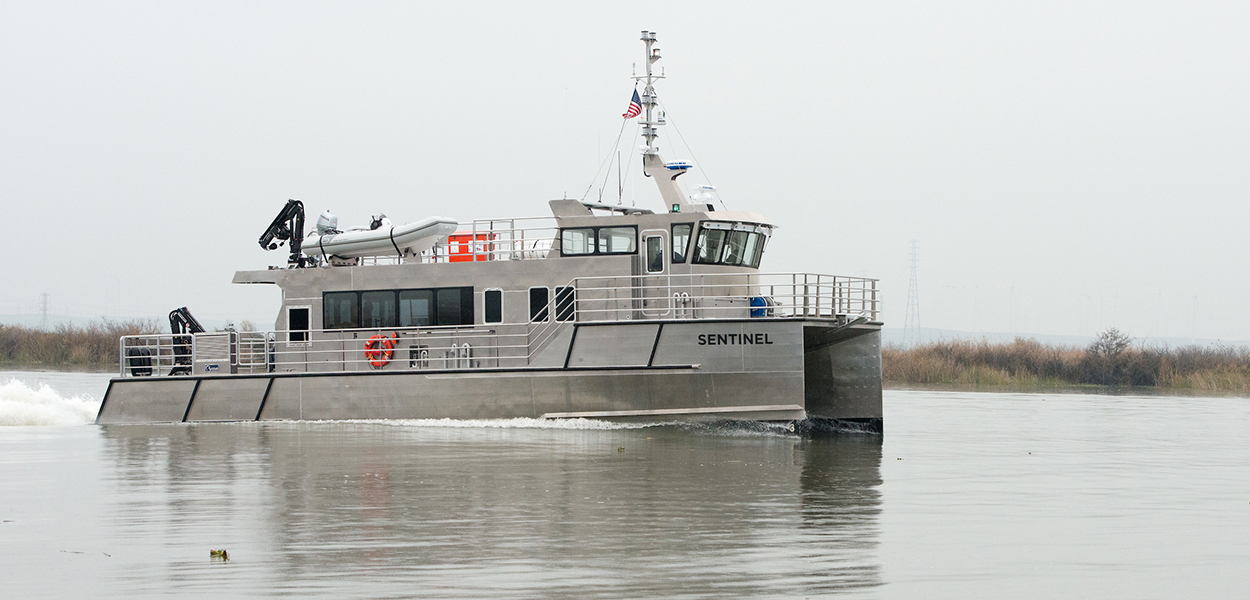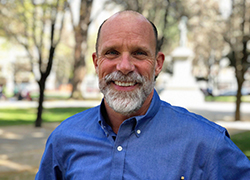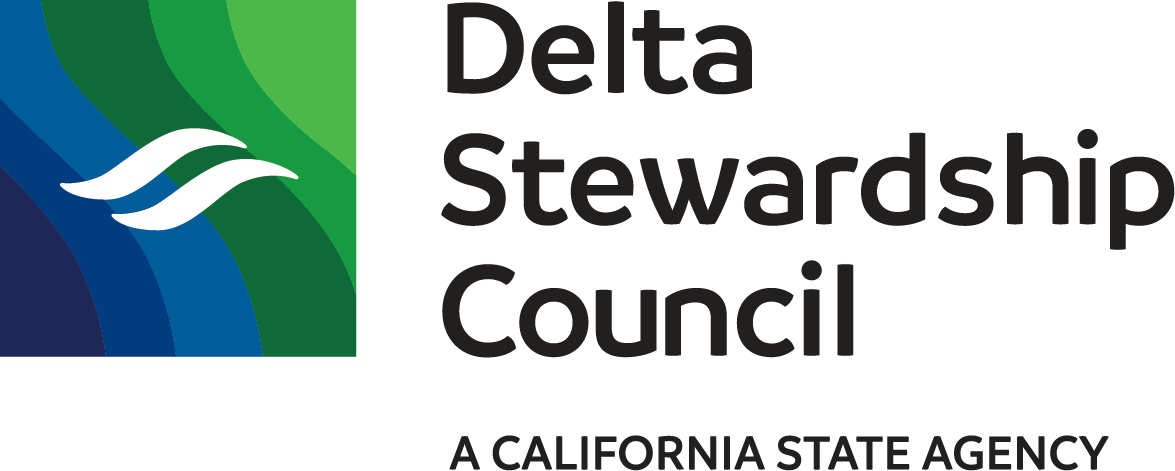
This year marks a significant milestone for the Interagency Ecological Program – 50 years of cooperative ecological monitoring and coordination. Pictured: A Department of Water Resources research vessel, the Sentinel, sails on the San Joaquin River near the Antioch bridge. Photo: Florence Low/California Department of Water Resources
Building Upon 50 Years of Interagency Ecological Science in the Bay-Delta
March 24, 2020
By Steven Culberson
This year marks a significant milestone for the Interagency Ecological Program (IEP) – now nine state and federal agencies that first joined forces 50 years ago for cooperative ecological monitoring and coordination in the Sacramento-San Joaquin Delta and San Francisco Bay Estuary. As the IEP Lead Scientist, I have been reflecting on who we are, how we’ve evolved, and what we need to do to ensure we’re still working collaboratively for another 50 years.
The IEP was born from a need to understand the ecological impacts of state and federal water projects on the Delta and the overall health of fish and wildlife throughout the estuary. Its early work – outlined in a Memorandum of Understanding among the California Department of Fish and Game, the California Department of Water Resources, the U.S. Fish and Wildlife Service, and the U.S. Bureau of Reclamation – helped establish some of the first biological standards in the country and set standards for long-term ecological monitoring and research in the Bay-Delta.
Today, in addition to its founding four members, the IEP has expanded to include the State Water Resources Control Board, the National Marine Fisheries Service, the U.S. Army Corps of Engineers, the U.S. Geological Survey, and the U.S. Environmental Protection Agency. The IEP also has several key partners, including the Delta Stewardship Council, which houses the IEP Lead Scientist position. Localizing the IEP lead scientist within the Delta Stewardship Council allows for stronger collaboration and communication between data collectors and data users, while advancing efforts toward the science community’s shared vision of One Delta, One Science.
Throughout its history, the IEP has successfully coordinated federal, state, and local research and monitoring programs in one of the most complex and politically contentious regions in the country. As a result, it has developed and maintained high quality, long-term data, research, and monitoring programs to inform both water operations and the management of critical native species like Delta smelt and salmon. The IEP continues to produce and integrate relevant and timely ecological information for management of the Bay-Delta ecosystem and the water that flows through it.
The need by decision makers for more forward-looking forecast science and synthesis to address tough questions around issues like climate change, however, continues to increase. To meet this growing need, the IEP must adjust and refine its approach to data collection and science synthesis and improve how it communicates with policymakers and natural resource managers who urgently need more accessible Bay-Delta science.
This is no small task.
Informed by internal IEP evaluations and external reviews from groups like the Delta Independent Science Board (Delta ISB), there are clear actions that the IEP can take in the immediate future to reinforce the long-term value and impact of its work:
- Improve external communication to more effectively inform policy and decisions
- Verify the need for the information that the IEP collects or change how that need is met
- Explore new ways to collect data and produce information, especially where overlap or gaps exist in current programs
At the heart of these actions is communication. Decision makers and scientists need to spend more time talking directly to one another. Where data collection and interpretation are concerned, it’s better to have decision makers working closely with policy-aware applied scientists than to risk miscommunication and continue the familiar game of telephone. Meaningful refinement cannot occur until we establish more useful communication between data collectors and data users – this cannot simply be creating effective products; we must develop effective interactions, too.
As scientists, we must continue to practice and improve how we communicate with our audiences. Ahead of this year’s annual IEP workshop now scheduled for August 25-27, I encourage presenters to connect their work to the Delta Science Plan, the Science Action Agenda, and initiatives like the Delta Independent Science Board and Delta Plan Interagency Implementation Committee’s Science Needs Assessment.
Also paramount in these discussions is the IEP’s monitoring focus. Despite the abundance of data that exists across the estuary, the Delta still lacks a cohesive monitoring program that connects water quality, ecological, and other data in a way that is meaningful for decision makers. It’s important to understand why we need information before we decide when and how to gather it. For example, as natural resource managers begin shifting toward more large-scale, multibenefit ecosystem restoration projects in the Bay-Delta, IEP monitoring must adapt to better document and assess management outcomes and reduce scientific uncertainties.
The IEP can contribute to this shift by sharpening its ability to provide both “compliance science” – monitoring that takes place to meet regulatory requirements set by the State Water Resources Control Board and other regulatory bodies – as well as more integrated, process-based monitoring, research, and synthesis. Part of this involves a concerted review of its long-term monitoring efforts, a move that was most recently recommended by the Delta ISB.
This is the first of a series of blog posts where I will discuss and explore the challenges and opportunities ahead for the IEP, as well as my perspectives as IEP lead scientist. I am committed to improving communication not just across the IEP community, but also with the decision makers who use IEP science, and I welcome any feedback or ideas on future blog discussions or the IEP’s work as a whole.
We must remember that sound and lasting science programs do not exist in a vacuum. Instead, the best science programs are strengthened by their accessibility, their responsiveness to feedback, and their ability to evolve to meet new and pressing challenges. Let’s get to work.
Additional Reading
- Interagency Ecological Program Science Strategy 2020-2024: Executive Summary (available upon request)
- Delta Independent Science Board: A Review of the Interagency Ecological Program’s Ability to Provide Science Supporting Management of the Delta
- Interagency Ecological Program Status & Trends 2017 Fall Season Report Water Quality: 1975 - 2017

About Steven Culberson
Interagency Ecological Program (IEP) Lead Scientist Steven Culberson interacts with and organizes the activities of dozens of agency and university scientists on behalf of IEP’s six federal and three state agencies through project work teams, synthesis teams, a science management team, and an IEP coordinators team. These interdisciplinary and collaborative efforts are the core of how the IEP works to inform Bay-Delta science and provide data and information in compliance with regulations governing the state and federal water projects, and for understanding the ecosystems that depend on the San Francisco Estuary. Culberson has been the IEP Lead Scientist since 2016.

